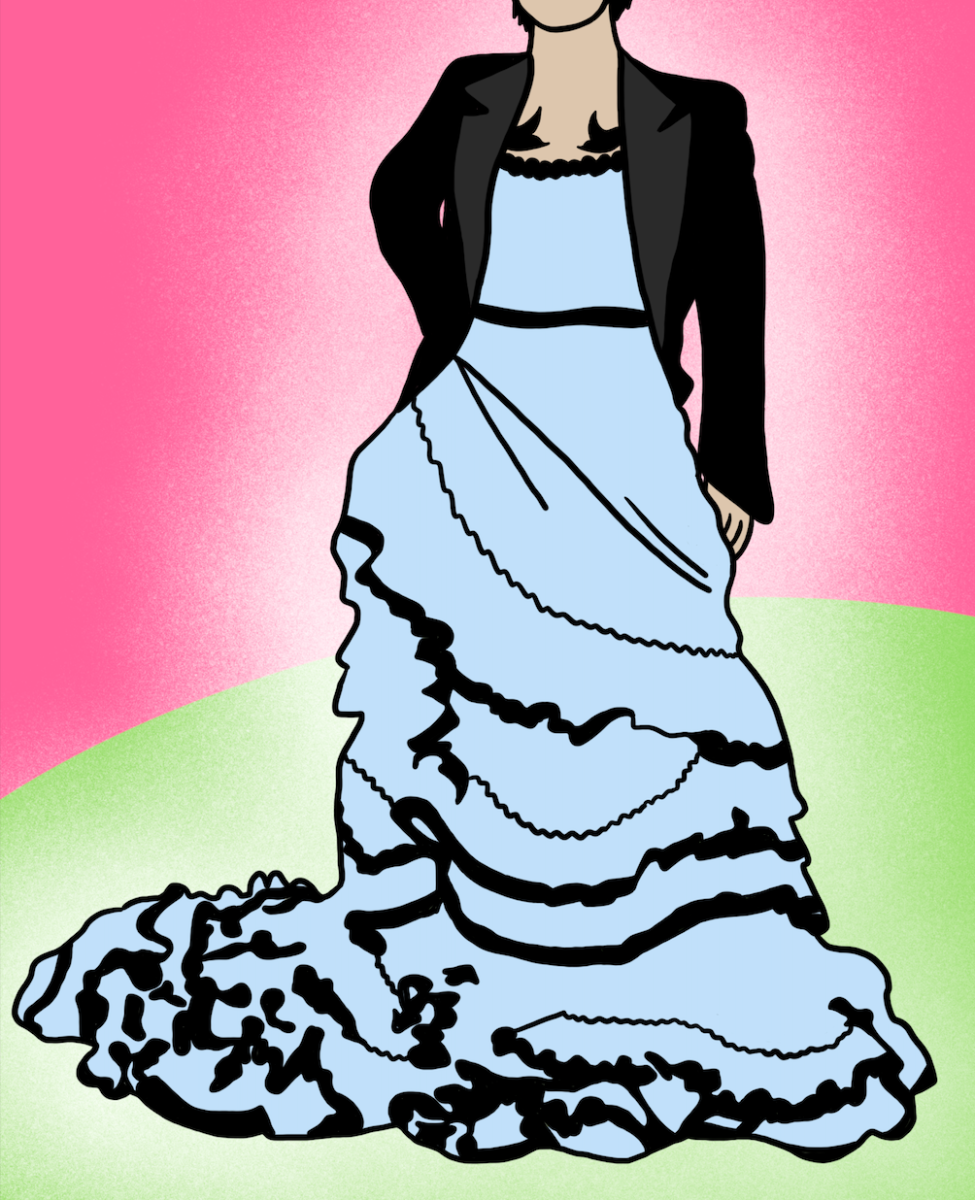Harry Styles made history as the first solo male to grace the cover of Vogue magazine for its December issue. He wore a blue, frilly dress on the cover with a black blazer overtop. Naturally, a divided discussion consumed social media immediately after the announcement and cover reveal Nov. 14.
Older generations might be stuck in the way things were, but young people are focusing on the way things should be. On the topic of clothing, specifically, the rules and restrictions are starting to blur. Men can wear dresses or skirts, and women can rock a suit.
Styles is known for wearing eccentric, loud outfits. He is pivotal in promoting acceptance for self-expression and gender identity exploration.
Candace Owens and Ben Shapiro were among the biggest names highly against Styles’ attire on the cover of the acclaimed fashion magazine. “Bring back manly men,” Owens wrote on Twitter in response to Vogue’s announcement. She promoted a discussion of what society deems acceptable for clothing standards, and her perspective is definitely not focused on progression.
In a way, Owens’ response sets women back. She implied “manly men” keep society going. In fact, she wrote, “there is no society that can survive without strong men.” Where does this statement leave women? Does this mean a man wearing a dress is no longer strong? Does clothing affect strength and agility? No, it does not.
Styles went to social media Dec. 2 to post a blatant response to Owens. He wore a blue oversized suit and captioned his image with Owens’ own words, “Bring back manly men.” He was clearly unbothered by her comments.
Some Texas State students and faculty heard about and saw the cover and were positive about Styles’ self-expression and confidence.
Joshua Jones, a computer science junior, believes people should be able to freely express themselves through clothing. He does not perceive masculinity in connection to clothing; he sees it in mannerisms connected through ego and pride. He enjoyed Styles’ cover.
“I don’t really see anything wrong with it. It looks good in my opinion. I know dresses are usually seen as a woman thing, but I think a guy can make their own style with it,” Jones said.
Margaret Weatherman, a geography and anthropology senior, believes society is going through a cultural reset and gender identity is at the forefront. She thinks masculinity is ever-evolving and does not see it meaning anything concrete at this point. She was also happy to see Styles’ cover shot.
“I loved it,” Weatherman said. “I think it’s breaking down boundaries. I think gender is an illusion and something that is not even real. I believe in androgyny and mixing gendered outfits because there is no such thing as gendered outfits, just what we perceive them to be.”
Dr. Kelly Jondle, a professor in the Fashion Merchandising Program, says she does not stay overly up to date with pop culture, but she was ecstatic to hear about Styles’ cover.
“Him doing that, wearing a dress, is amazing because it takes someone in his role and his following to be like “you know what, this is just how it is.” Not everyone can do that, and it kind of gives other people the confidence to say ‘Dude, he’s wearing a dress. I can wear whatever I want to wear,’” Jondle said.
Although Styles is necessary context for the current spark in the gender normative clothing discussion, he is not the focal point—or really the point at all. He is also not the first man to unapologetically be himself and explore clothing beyond socially constructed limits.
“It’s not anything new…we’ve seen all kinds of crazy stuff over the years; this might just be the first time that a younger person that really identifies with the whole younger generation has done something,” Jondle said.
The attributes aligned with masculinity and femininity are socially constructed; they are not set in stone. They are created through cultural norms and based on tradition, but like all things formed from tradition, they are subject to discussion and change.
Looking back in history, Egyptians wore eyeliner and garments similar to dresses and skirts, and there was no cultural division because those characteristics were not perceived as feminine. Additionally, women did not always wear pants. The first women who did were considered scandalous.
“When things are new it’s shocking,” Jondle said. “Even like songs, a new song, or new foods and new flavors you think, ‘I don’t know what I think.” And before you know it, you’ve heard the song so much, it’s not new anymore, and you’re over it. I don’t know when that time will be [in this case,] but I hope that down the road it’ll be like people wearing heels and dresses…wearing whatever.”
Alex Kendrick, a studio art freshman, did not have the luxury of always wearing what she wanted growing up. She says she grew up in a strict Catholic household where women wore dresses and men wore suits, “no in between.”
Kendrick is non-binary, and although she feels more freedom in college, she is still tied to her family who is not entirely accepting of her breaking societal norms. Her mom is at least accepting of the fact she won’t strictly wear dresses if she does not want to.
“I’ll sometimes wear a dress or sometimes I’ll wear a pantsuit or shorts and t-shirt, whatever makes me feel comfortable,” Kendrick said.
Creating hard limits on gender norms is not going to be a smooth process. Things are changing and society is evolving. Men can wear nail polish, grow out their hair and wear dangly earrings—and they should not be judged for it.
“In the fashion program, we see a little of everything, so I’m not really thrown off by what I see. I’m actually like, ‘wow, that’s pretty cool,’ someone being so confident in themselves. Like, guys wearing makeup or cropped shirts or heels,” Jondle said.
Traditions are hard to break or change. Humans rely on routines and things that feel concrete to feel comfortable. Acceptance to drastic changes in the way things usually are will not come easy, but it is important to continue conversations and have open discussions.
Clothing is just fabric people wear to be appropriate in public. It takes on different patterns and styles. At times, it creates a mood and enhances confidence. It is powerful and symbolic. However, it is not attached to gender roles.
“It’s just a dress,” Jondle said. “We’re giving a different meaning to the dress.”
– Laura Nunez is an adverting senior
The University Star welcomes Letters to the Editor from its readers. All submissions are reviewed and considered by the Editor-in-Chief and Opinion Editor for publication. Not all letters are guaranteed for publication.
Opinion: Clothing is not tied to gender roles
Laura Nunez, Opinion Editor
December 7, 2020
0
Donate to The University Star
Your donation will support the student journalists of Texas State University. Your contribution will allow us to purchase equipment and cover our annual website hosting costs.
More to Discover














